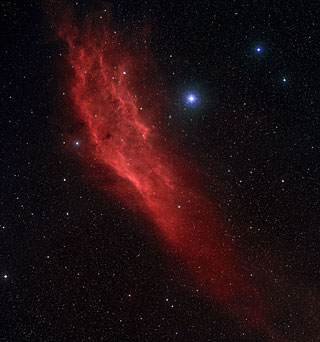Chris Peterson wrote: ↑Fri Apr 28, 2023 1:50 pm
zendae wrote: ↑Fri Apr 28, 2023 6:19 am
So let's say S5-HVS1 had a couple planets. Are they still in capture by the star hurtling thru space, or has all the upheaval overcome the gravity that held them? Have they become runaway planets, now alone in the dark?
It's perfectly possible for a star to be ejected from a cluster or star forming region and retain its planets, although the tidal forces might well alter the orbits of those planets.
I'm not arguing (very much), Chris, but note that all but one of the more nearby runaway stars that I showed pictures of in my "gallery" appear to be single.
Wikipedia wrote about Alpha Cam:
In 1968, this star was classified as a spectroscopic binary, indicating that it has an orbiting stellar companion with a period of 3.68 days and an orbital eccentricity of 0.45. Subsequent studies refined the period to 3.24 days.
However, in 2006 it was recognized that the changes in the spectrum were probably the result of changes in the atmosphere or stellar wind, so it is more likely a single star.[11] Speckle interferometry observations with the 3.67 m Advanced Electro Optical System Telescope at the Haleakala Observatory failed to detect a secondary component.
Wikipedia wrote about Zeta Ophiuchi:
Zeta Ophiuchi (ζ Oph, ζ Ophiuchi) is a single star located in the constellation of Ophiuchus.
Wikipedia wrote about AE Aurigae:
Possibly due to its runaway star nature, AE Aurigae has no physical companion stars, although some nearby stars have been erroneously identified as ones.
Wikipedia doesn't say that Xi Persei is single, but nothing is said about any companions.
Wikipedia also doesn't say that Kappa Cassiopeiae is single, but again, nothing is said about a companion.
However,
Vela X-1 is a binary system consisting of blue supergiant star HD 77581 and a neutron star. This is a runaway system, so clearly it is possible for gravitationally bound systems to remain bound even after they have received a gravitational kick and become runaways.
My point, nevertheless, is that massive runaway stars often appear to be single, whereas massive "non-runaway stars" are more often multiple.
Take the bright blue stars of constellation Orion, for example.
Rigel is multiple.
Alnitak is multiple. Mintaka, Delta Orionis, is multiple.
Meissa, Lambda Orionis, is multiple. However, Saiph, Alnilam and Bellatrix have no known companions.
So it seems to me that runaway stars appear to be single more often than stars that are not runaways. Of course, whether that has anything to do with a star's ability to hold on to its own planets when it receives a huge gravitational kick is beyond my poor mathematical understanding.
Ann
 Runaway Star Alpha Camelopardalis
Runaway Star Alpha Camelopardalis




